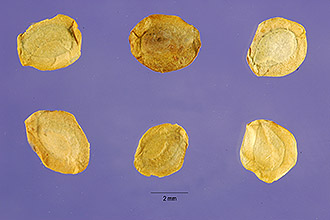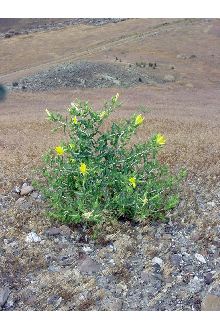Smoothstem Blazingstar
Scientific Name: Mentzelia laevicaulis (Hook.) Torr. & A. Gray

| General Information | |
|---|---|
| Usda Symbol | MELA2 |
| Group | Dicot |
| Life Cycle | BiennialPerennial, |
| Growth Habits | Forb/herb |
| Native Locations | MELA2 |
Plant Guide
Alternate Names
Blazing star, giant blazingstar, blazing-star mentzelia, beautiful blazingstar, stickleaf, Bartonia laevicaulis Douglas, Nuttallia laevicaulis (Douglas) Greene
Uses
Pollinator Habitat: Smoothstem blazingstar is a source of nectar and pollen for native bees, butterflies and moths (Mee et al 2003). Rangeland: This plant can be used for revegetation and diversification of rangeland, particularly on harsh, rocky sites. Forage: Smoothstem blazingstar is undesirable as forage to both livestock and wildlife. Ethnobotanical: The Cheyenne used the roots of this plant to treat rheumatism, arthritis, earaches, fevers, mumps, measles and smallpox, as well as other complicated diseases. They also used the roots for thirst prevention. The Gosiute applied an infusion of the roots to bruised swellings. The Montana and Mendicino made a decoction of the leaves and applied it as a wash for skin diseases, and drank it for stomachaches. The Paiute used it as a source of food; they cooked the seeds in water and used it for a gravy (Native American Ethnobotany Database 2010). Ornamental: Hitchcock and Cronquist (1973) state this and a related species, M. decapetala are “beautiful-flowered and desirable garden subjects for dry areas, especially the eastern Cascades”. According to Mee et al (2003) the plant is well-suited for a rock garden, steppe garden, or rocky slopes and is self seeding. However, it is difficult to transplant due to its taproot and barbed leaves.
Status
Please consult the PLANTS Web site and your State Department of Natural Resources for this plant’s current status (e.g., threatened or endangered species, state noxious status, and wetland indicator values).
Weediness
This plant has a weedy appearance and is often found growing in association with weeds, however it is not weedy; it does not aggressivelydominate an area. Bumble bee visiting a Mentzelia laevicaulis flower. Pamela Pavek
Description
General: Loasa family (Loasaceae). Mentzelia laevicaulis is a native biennial or short-lived perennial that has a deep taproot and a single, branched stem 0.3 to 1 m (1 to 3.2 ft) tall. Leaves are 3 to 15 cm (1.2 to 6 in) long, lobed, alternate, brittle, and have a barbed pubescence that cause the leaf to “readily [attach] to any foreign object touched” (Hitchcock and Cronquist 1973). The plant blooms June through September (Knopf 2001). Flowers are star-like, yellow, and have 5 linear, sharp-pointed petals 2.5 to 8 cm (1 to 3 in) long. The flower also has about 50 filaments, 2 to 4 cm (0.8 to 1.6 in) long. Five of the outer filaments are sometimes flattened, have no anthers and have the appearance of petals, however are narrower than the true petals (Hitchcock and Cronquist 1973). Some sources report flowers fully bloom only when the sun is bright (Lyons and Merliees 1995) however others claim flowers are fully open only during nighttime hours (Grant 1983). The flower has one style which extends above the cup-shaped nectary on top of the inferior ovary (Grant 1983). The ovary is one-celled and develops into a cylindrical capsule 1.5 to 3.5 cm (0.6 to1.4 in) long. It contains multiple grayish-brown, flattened and wing-margined seeds (Darlington 1934; Hitchcock and Cronquist 1973; Burke Museum of Natural History and Culture 2010). Mentzelia laevicaulis seeds. Robert J. Gibbons, U.S. National Seed Herbarium The genus name Mentzelia refers to Christian Mentzel (1622-1701) who was a German botanist, botanical author, philologist, personal physician to the Elector of Brandenburg, and the father of the first King of Prussia (Charters 2010). The species name laevicaulis translates to smooth-stemmed in Latin (Charters 2010). The description smooth-stemmed is relative; the upper stems of M. laevicaulis are typically covered with short and stiff barbed hairs, however the stems are smoother than other Mentzelia species (Rogers 2003). This plant was first named by David Douglas, who collected it “on the gravelly island and rocky shores of the Columbia [River] near the ‘Great Falls’” (Darlington 1934). Douglas named the plant Bartonia laevicaulis. Sir William Hooker published this name along with the first description of the plant in 1834 in a section of Flora Boreali-Americana. John Torrey and Asa Gray changed the name of the plant to Mentzelia laevicaulis in 1840 when they published Flora of North America (Darlington 1934). Distribution: Mentzelia laevicaulis is found in most western states: Colorado, Wyoming, Utah, Nevada, Idaho, Montana, Washington, Oregon, and California, and the Canadian province of British Columbia. The taxon is divided into two varieties (ecotypes): M. laevicaulis var. laevicaulis and M. laevicaulis var. parviflora. Var. laevicaulis is found throughout the entire range of the species and has petals at least 4 cm (1.6 in) long and seed capsules more than 2 cm (0.8 in) long. Var. parviflora is found only in Washington and British Columbia, and has petals 1.5 to 4 cm (0.6 to 1.6 in) long and seed capsules less than 2 cm (0.8 in) long (Hitchcock and Cronquist 1973, USDA NRCS PLANTS Database 2010). For current distributions, please consult the Plant Profile page for this species on the PLANTS Web site. Habitat: Smoothstem blazingstar grows in mountain brush, pinyon-juniper, shrub steppe, cool desert shrub, salt desert shrub, and ponderosa pine habitats (Lyons and Merilees 1995; Mee et al 2003).
Adaptation
This plant is adapted to open, sunny areas receiving 18 to 38 cm (7 to 15 in) precipitation at elevations up to 2,700 m (8,000 ft) (Rogers 2003). It grows in dry, sandy or gravelly soil, on disturbed sites, road cuts and talus slopes, in canyons, valleys and dry foothills (Darlington 1934; Mee et al 2003).
Establishment
Mentzelia laevicaulis can be established by seed or transplanted seedlings. Seed should be planted in a late dormant winter planting (November or December) with a drill into a weed-free seed bed at a rate of 6 kg PLS/ha (7 lbs PLS/ac) (Lambert 2005) and at a depth of 1.3 – 0.6 cm (0.5 – 0.25 in). If included in a mix the seed rate should be adjusted according to the proportion of the mix, and if the seed is broadcast the rate should be doubled. Seedlings are difficult to transplant due to their taproot which prevents a tight plug from developing. Also the barbed pubescence on the leaves causes the plants to cling to each other and to clothing. Skinner (2007) states “because of this, care must be exercised in handling the plants to prevent uprooting of the seedlings. Uprooted seedlings do not survive when replanted”. Transplanted seedlings should be spaced 0.6 to 0.9 m (2 to 3 ft) apart. Seedlings planted at the Washington State University Experiment Station in Othello were slow to establish. Only when temperatures increased in mid June did they begin to grow rapidly. Plants did not survive the first winter, however produced new plants by seed.
Management
Managing weeds with hand hoes and wheel hoes can be detrimental to Mentzelia laevicaulis plants. Plants barely touched with equipment can dislodge from the ground. For this reason, it may be impossible to mechanically harvest seed of Mentzelia laevicaulis, unless the plant is treated like an annual and reseeded every year.
Pests and Potential Problems
None , Use soil moisture sensors to measure the soil moisture of Smoothstem Blazingstar.
Environmental Concerns
Concerns
Concerns
None
Seeds and Plant Production
Plant Production
Plant Production
There are 660,000 seeds per kilogram (300,000 seeds per pound) (Lambert 2005). The seed requires a cold-moist stratification period for optimal germination. Skinner (2007) found 10% seed emergence without stratification, 48% emergence with 30 days stratification, and 65% emergence with more than 90 days stratification. Also, some seed germinated after a second winter. The author obtained 99% emergence in cones seeded with 2 – 3 seeds per cone after 60 days of stratification. Seedlings can be produced by sowing the seed in containers in the fall outdoors and moving the containers into a greenhouse in January. Germination begins in 6 to 7 days and is complete in 10 to 12 days (Skinner 2007). In April the plants can be moved to a cold-frame for 2 to 4 weeks to be hardened off prior to transplanting in late April or early May. If planting earlier is necessary to take advantage of the spring moisture (on very dry sites) the stratification period could be moved ahead or an artificial stratification procedure could be used (Skinner 2007). Cultivars, Improved, and Selected Materials (and area of origin) None
References
Burke Museum of Natural History and Culture. [Online]. Available at: http://biology.burke.washington.edu/herbarium/imagecollection.php (accessed 17 Dec 2010). University of Washington, Seattle, WA. Charters, M.L. 2010. California Plant Names: Latin and Greek Meanings and Derivations. [Online] Available at: http://www.calflora.net/botanicalnames/ (accessed 16 Dec 2010). Darlington, J. 1934. A monograph of the genus Mentzelia. Annals of the Missouri Botanical Garden 21:103 –226. Grant, V. 1983. The systematic and geographical distribution of hawkmoth flowers in the temperate North America flora. Bot. Gaz. 144:439 -449. Hitchcock, C.L. and A. Cronquist. 1973. Flora of the Pacific Northwest. University of Washington Press, Seattle and London. Knopf, A.A. 2001. National Audubon Society Field Guide to Wildflowers, Western Region. Chanticleer Press, New York, NY. Lambert, S. 2005. Guidebook to the Seeds of Native and Non-Native Grasses, Forbs and Shrubs of the Great Basin. Idaho BLM Technical Bulletin 2005-04. United States Department of the Interior, Bureau of Land Management, Boise, ID. Lyons, C.P. and B. Merilees. 1995. Trees, Shrubs and Flowers to Know in Washington and British Columbia. Lone Pine Publishing, Auburn, WA and Vancouver, BC. Mee, W., J. Barnes, R. Kjelgren, R. Sutton, T. Cerny, C. Johnson. 2003. Waterwise: Native Plants for Intermountain Landscapes. Utah State University Press, Logan, UT. Native American Ethnobotany Database. 2010. [Online] Available at http://herb.umd.umich.edu/ (Accessed 16 Dec 2010). University of Michigan, Dearborn, MI. Rogers, D. Mentzelia laevicaulis (Douglas) Torrey & Gray, Blazing Star. Double Cone Quartlerly. Ventana Wilderness Alliance Vol. VI No. 2. [Online] Available at: http://www.ventanawild.org/news/fe03/mentzelia.html (Accessed 16 Dec 2010). Skinner, Dave. 2007. Propagation protocol for production of container Mentzelia laevicaulis (Dougl. ex Hook.) Torr. & Gray plants; USDA-NRCS Pullman Plant Materials Center, Pullman WA. In: Native Plant Network [Online] Available at: http://www.nativeplantnetwork.org (Accessed 16 Dec 2010). University of Idaho, College of Natural Resources, Forest Research Nursery, Moscow, ID.

